COMMENT | Re-opening Parliament: Who really gets to decide?
COMMENT | One of the most basic and fundamental principles undergirding the Federal Constitution is that of the practice of constitutional monarchism. As a learned and respected law professor had once written, the king reigns but does not rule. In exercising most, though not all, of the functions of the Yang di-Pertuan Agong, he acts on advice, and must follow the advice that has been rendered to him.
The learned attorney-general is therefore absolutely correct to refer to Article 40(1) of the Federal Constitution in helping us to understand the interplay between the reign of the Agong on the one hand, and the rule of the government of the day on the other. To quote:
“In the exercise of his functions under this Constitution or federal law the Yang di-Pertuan Agong shall act in accordance with the advice of the cabinet or of a minister acting under the general authority of the cabinet, except as otherwise provided by this Constitution….”
This is a provision that has been in the Federal Constitution since 1957, and represents the way in which a constitutional monarchy is intended to work.
Just in case the meaning and intent of Article 40(1) are not clear to anyone, Article 40(1A) was inserted in effect from June 24, 1994. The learned attorney-general has also correctly referred to this:
“In the exercise of his functions under this Constitution or federal law, where the Yang di-Pertuan Agong is to act in accordance with advice, on advice, or after considering advice, the Yang di-Pertuan Agong shall accept and act in accordance with such advice.
We should recall the environment existing at the time this amendment was made. Between 1993 and 1994, the government of the day led by...
RM12.50 / month
- Unlimited access to award-winning journalism
- Comment and share your opinions on all our articles
- Gift interesting stories to your friends
- Tax deductable
